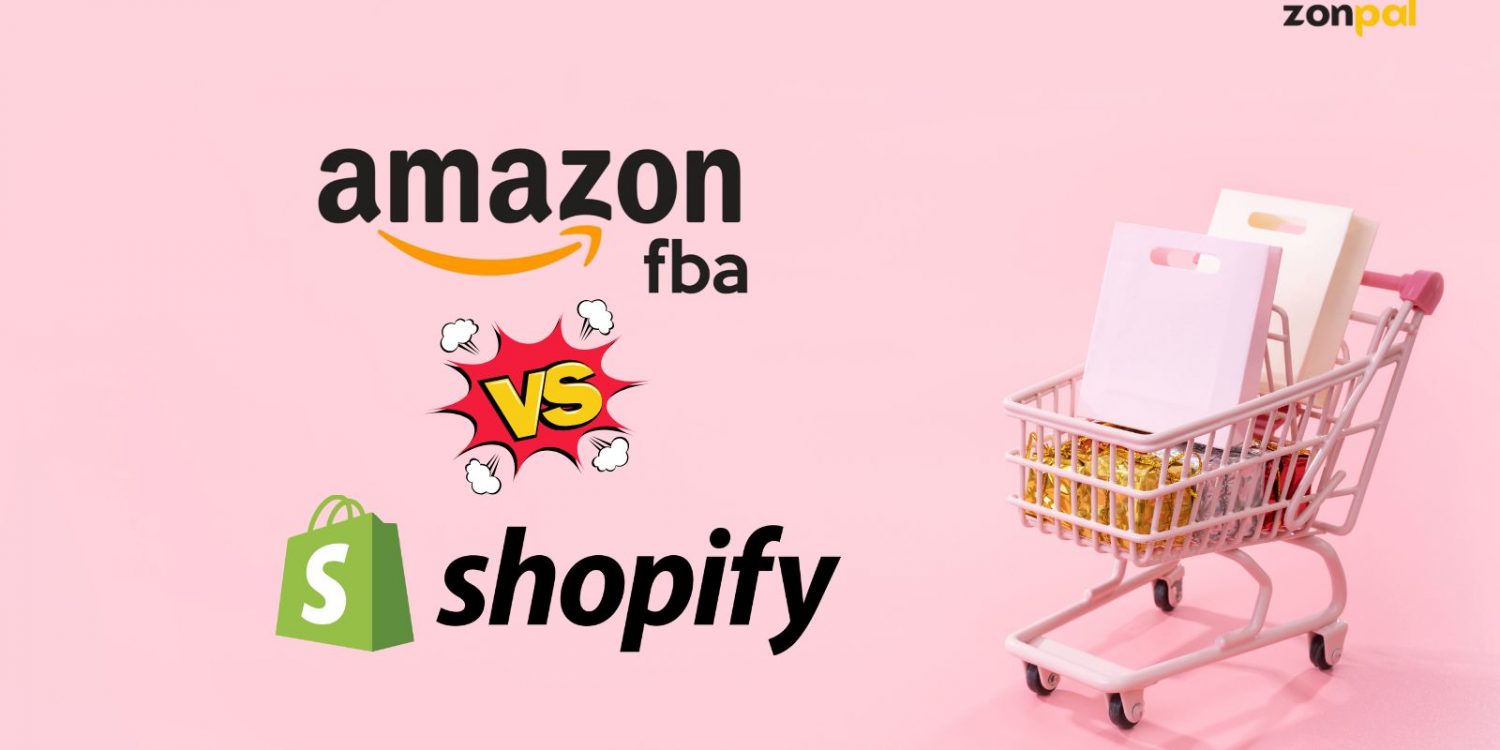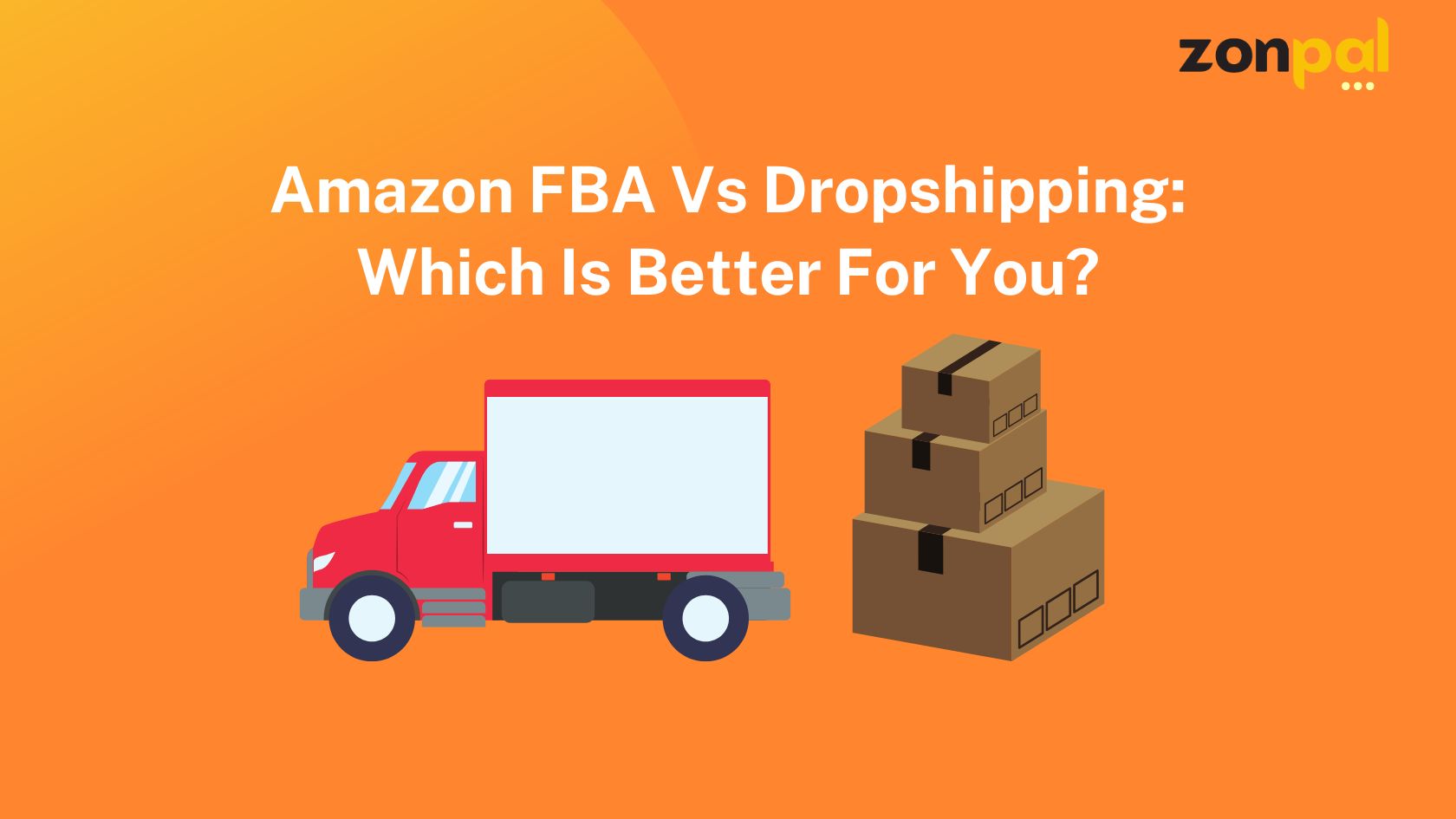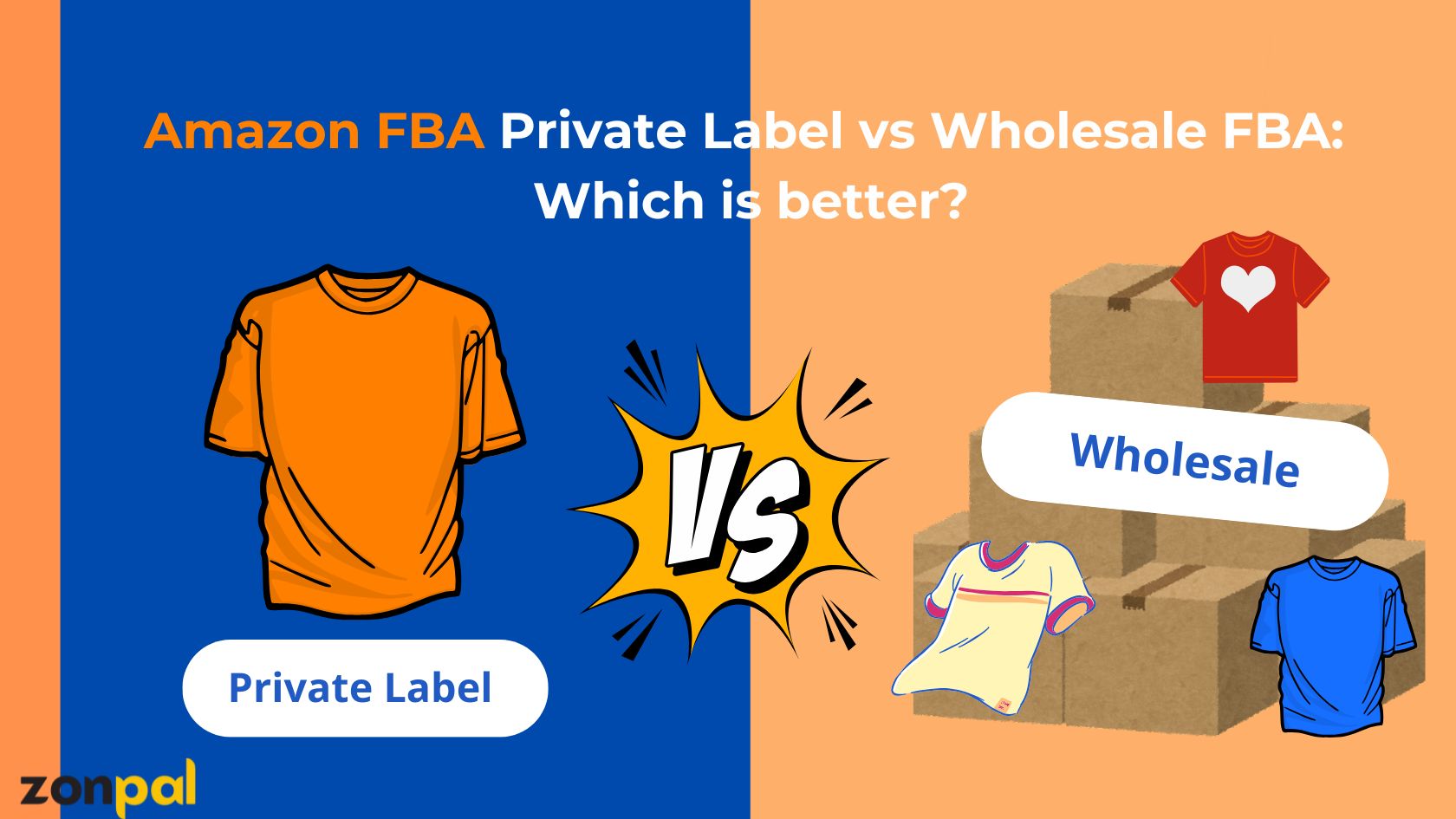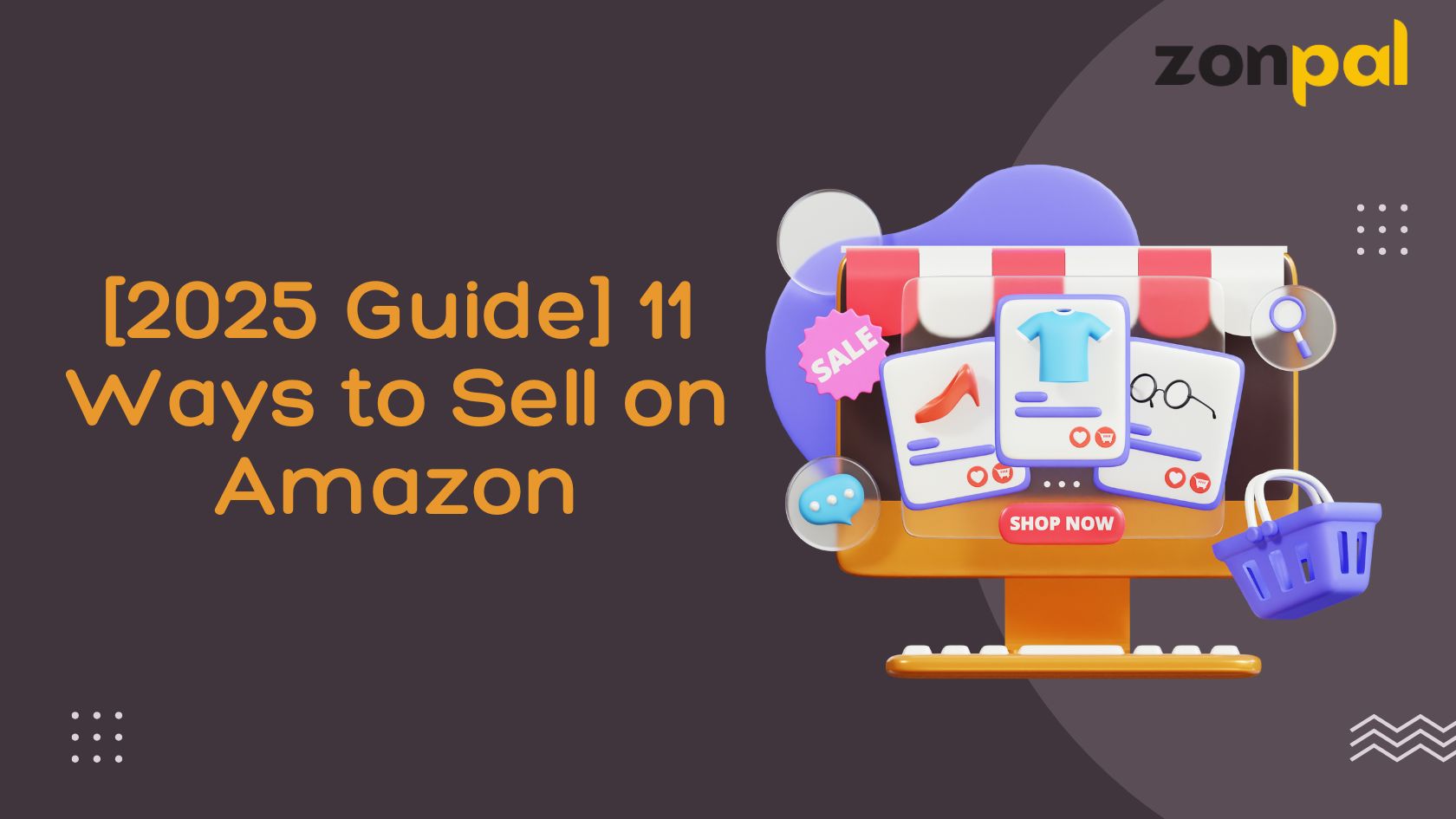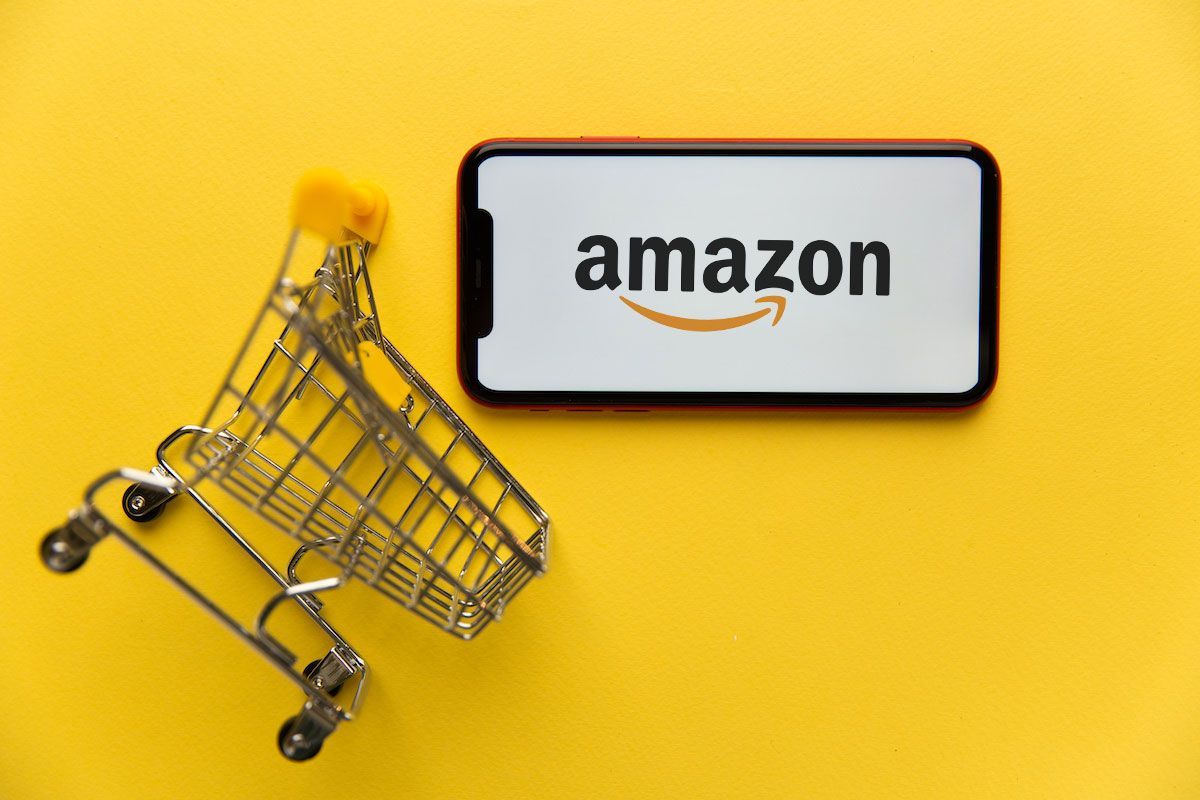Amazon FBA Vs Shopify: Which Model Should You Choose?
When starting an online business, two of the most talked-about models are Amazon FBA and Shopify dropshipping. Both provide the potential for profitable eCommerce success, but they build on very different foundations. You’re not alone if you’ve been weighing your options between these two. Many aspiring entrepreneurs find themselves at this very crossroads.
In this post, we will compare Amazon FBA vs Shopify. We will look at the real pros and cons, cost comparisons, and see if you can combine both models effectively.
What’s The Difference Between Selling On Amazon vs Shopify?
At their core, both Amazon FBA and Shopify allow you to sell physical products online. However, the biggest difference lies in the platform ownership and fulfillment responsibilities. Let’s break it down.
- Amazon FBA (Fulfillment by Amazon):
With Amazon FBA, you send your inventory to Amazon’s warehouses. When someone places an order, Amazon handles the picking, packing, and shipping—as well as customer service and returns. You’re selling on Amazon’s marketplace, meaning you benefit from their built-in traffic and trust.
Example: Let’s say you sell yoga mats. You’d source the mats, send them to Amazon, create your FBA listing, and let Amazon do the rest.
- Shopify Dropshipping:
With Shopify, you create your own eCommerce website and integrate with dropshipping suppliers (e.g., via Oberlo, DSers, or Spocket). When a customer orders, the supplier ships the product directly to them. You never hold inventory.
Example: You set up a Shopify store selling novelty mugs, and when someone buys, your supplier prints and ships it on your behalf.
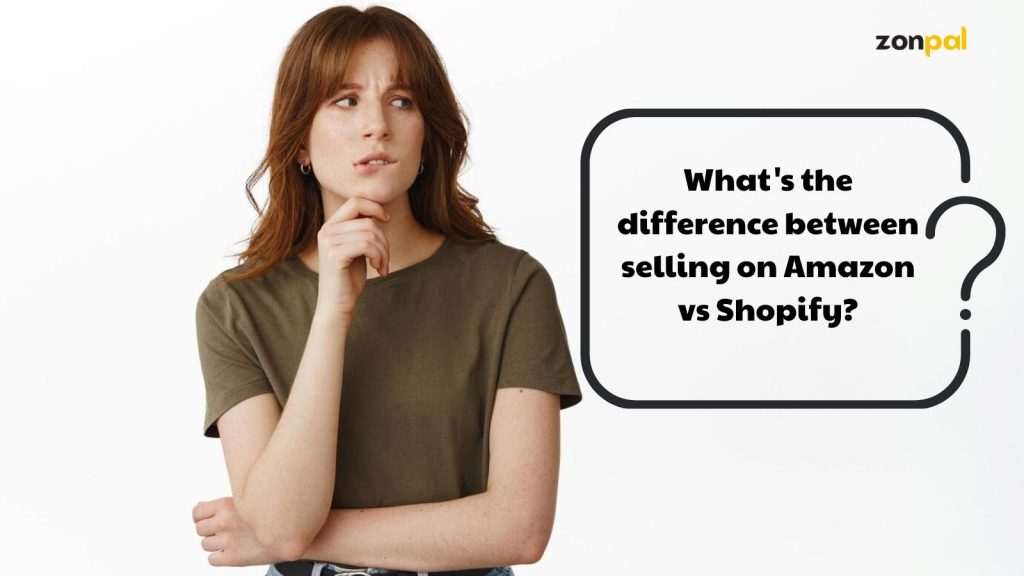
What’s The Difference Between Selling On Amazon vs Shopify?
Here’s a quick comparison:
|
Feature |
Amazon FBA |
Shopify |
|---|---|---|
| Platform | Marketplace | Website builder |
| Platform traffic | Amazon’s built-in audience | Must run your own ads (FB, Google, etc.) |
| Fulfillment | Done by Amazon | You manage fulfillment or use 3PLs |
|
Customer Data |
Amazon owns it |
You own customer data |
| Startup costs |
Higher (inventory, shipping, FBA fees) |
Lower (website, ads, apps) |
The Pros & Cons Of Shopify Vs Amazon FBA
Choosing the right eCommerce platform is not just about features. It is also about aligning your business goals with the right structure. Below, we will look at the pros and cons of Shopify and Amazon FBA. We will provide real-world examples to help you make a smart choice.
Pros & Cons Of Shopify
If you want to start your own eCommerce business and build a brand, Shopify is a great choice. It has an easy-to-use interface and strong customization tools. Shopify lets anyone, whether they are tech-savvy or not, create an online store without needing to write any code.
But like any business model, selling on Shopify comes with both exciting advantages and notable challenges. Below, we break down the real pros and cons to help you decide if this route aligns with your goals.
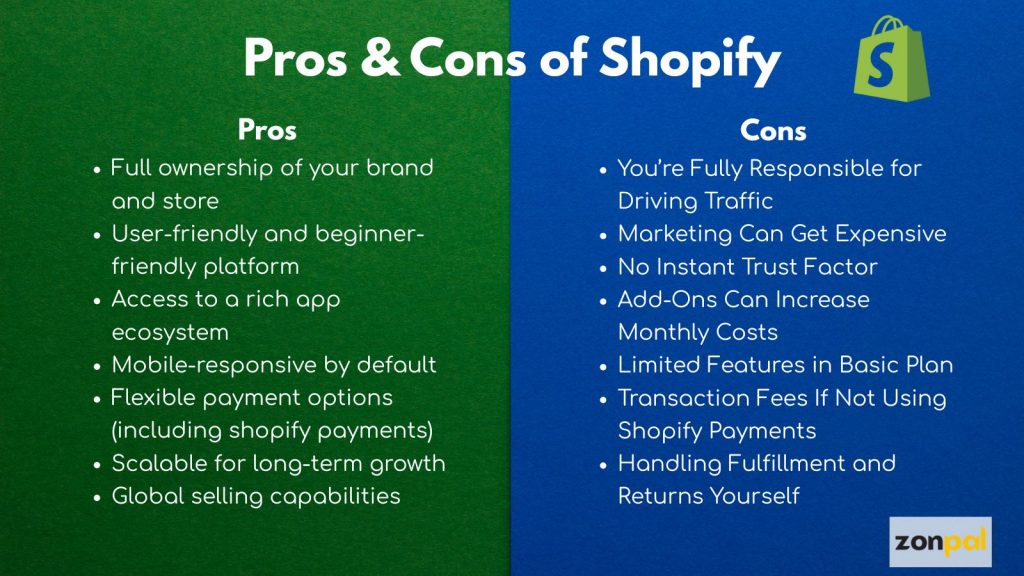
Pros & Cons Of Shopify
- Pros of Shopify:
- Full Ownership Of Your Brand And Store
With Shopify, you create your website with your own domain name. This gives you complete freedom to design your store as you like. You can guide your customer’s journey from the homepage to checkout. This helps strengthen your brand identity without distractions or other sellers.
- User-Friendly And Beginner-Friendly Platform
Even if you’ve never created a website before, Shopify makes it straightforward. Its drag-and-drop builder, pre-designed themes, and helpful tutorials allow you to get up and running in just a few hours. You don’t need any coding skills or design experience to create a polished, professional storefront.
- Access To A Rich App Ecosystem
Shopify provides access to many apps and integrations that can improve your store. These include tools for inventory management and customer support. You can also find advanced marketing features like upsells, email flows, and abandoned cart recovery.
- Mobile-Responsive By Default
All Shopify themes work well on mobile devices. This is important because over half of online shopping is done on smartphones. You don’t need to worry about making a separate mobile site. Your store will adjust to every screen automatically.
- Flexible Payment Options (Including Shopify Payments)
Shopify Payments lets you accept major credit cards easily. You don’t need a third-party processor. Plus, you will save on transaction fees. If you prefer another provider (like PayPal or Stripe), you can integrate it easily, too.
- Scalable For Long-Term Growth
Whether you’re selling one product or one thousand, Shopify can grow with your business. As you scale, you can upgrade to more advanced plans with features like professional reporting, international selling, and multi-location inventory management.
- Global Selling Capabilities
With currency conversion, multilingual apps, and Shopify Markets, you can sell to customers worldwide. This helps you grow beyond your local audience from the start.
⚠️In short: Shopify empowers you to build a brand on your terms. You’re not only selling products, but you’re also crafting a unique customer experience and laying the foundation for long-term growth.
- Cons of Selling on Shopify
- You’re Fully Responsible for Driving Traffic
Unlike Amazon, Shopify doesn’t have a built-in customer base. You need to bring people to your store. You can do this with SEO, content marketing, paid ads, influencer partnerships, or social media. If you don’t have a clear marketing plan, sales won’t come automatically.
- Marketing Can Get Expensive
While Shopify gives you the tools, it doesn’t pay for the clicks. Many new sellers rely a lot on Facebook, Instagram, or Google ads. These ads can quickly reduce profits if not managed well. If you don’t know your customer acquisition costs, it’s easy to overspend.
- No Instant Trust Factor
New stores have no reviews, no social proof, and no reputation to fall back on. Gaining customer trust takes time, especially when you’re competing against household names or Amazon sellers with hundreds of 5-star reviews.
- Add-Ons Can Increase Monthly Costs
While Shopify’s base plan is affordable, many essential features (like advanced analytics, email automation, or currency conversion) require paid apps. Over time, the monthly cost can climb significantly, depending on what your store needs.
- Limited Features in Basic Plan
Shopify’s Basic plan doesn’t include advanced reports or analytics. That means you’ll need to either upgrade your plan or track key data manually using tools like Google Analytics to understand your performance.
- Transaction Fees If Not Using Shopify Payments
You will pay extra transaction fees if you use a third-party payment gateway instead of Shopify Payments. This can reduce your profits, especially if you sell low-cost products.
- Handling Fulfillment and Returns Yourself
You need to pack and ship every order. This is necessary unless you use a third-party logistics (3PL) service or the Shopify Fulfillment Network. You will also need to manage returns. This can quickly become overwhelming as you scale.
⚠️ Bottom line: While Shopify gives you total control, that freedom comes with responsibility. Without a strategy for traffic, marketing, and logistics, it’s easy to feel stuck—even with a beautiful website.
Pros & Cons Of Amazon FBA
Amazon isn’t just a platform, it’s a global powerhouse in eCommerce. With over 300 million active users worldwide, it’s often the first place shoppers go when they’re ready to buy. For entrepreneurs, this creates an incredible opportunity: You don’t need to build your website or find your audience because Amazon e-commerce platform already has both.
But is that enough to make it the right fit for your business? Let’s explore the real pros and cons of selling through Amazon FBA to help you decide.
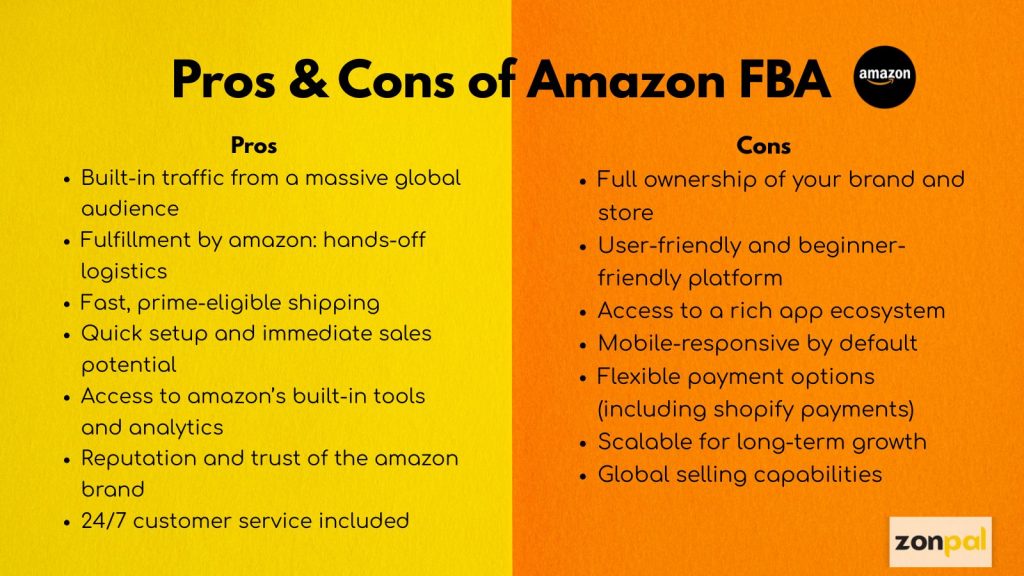
Pros & Cons Of Amazon FBA
- Pros of Selling on Amazon FBA
- Built-In Traffic from a Massive Global Audience
One of the biggest advantages of Amazon is that you gain instant access to millions of buyers who are already searching for products. You don’t need to drive traffic or build trust from scratch since people already trust Amazon.
With the right keywords, a good listing, and a well-managed Amazon PPC, your product can reach eager shoppers quickly.
- Fulfillment by Amazon: Hands-Off Logistics
With FBA, Amazon stores your inventory, packs your orders, ships them to customers, and even handles returns and customer service. This takes a huge burden off your shoulders, especially if you’re scaling or want to run your business from anywhere.
In many cases, sellers never touch a single product themselves.
- Fast, Prime-Eligible Shipping
Products enrolled in FBA get the Prime badge, which boosts credibility and unlocks free 1–2 day shipping for millions of Prime members. This alone can dramatically increase conversions, especially for impulse buys or everyday essentials.
- Quick Setup and Immediate Sales Potential
Once your account is set up and your products are live, you can start making sales almost instantly. Some sellers report their first sale within hours of listing a product, especially in high-demand niches.
- Access to Amazon’s Built-In Tools and Analytics
Amazon provides robust data on sales, traffic, inventory health, and customer behavior. These insights allow you to make smarter decisions around pricing, stock levels, and advertising.
- Reputation and Trust of the Amazon Brand
When buyers shop on Amazon, they’re buying with confidence, thanks to the platform’s strict policies, review system, and buyer protection. This trust factor works in your favor, especially when you’re a new seller trying to build credibility.
- 24/7 Customer Service Included
Amazon handles all customer inquiries, returns, and complaints for FBA orders. This means you won’t need to be online 24/7 answering emails; Amazon’s team does that for you.
⚠️ In short: Amazon FBA lets you sell to a massive audience with very little friction. You can focus on sourcing and growing your product line while Amazon handles the heavy lifting of logistics, service, and trust.
- Cons of Selling on Amazon FBA
- Amazon Fees Can Be Steep
While FBA is convenient, it comes at a price. You’ll pay:
- A referral fee (typically 15% of each sale)
- FBA storage and fulfillment fees
- Possible long-term storage penalties
- Combined, these fees can eat into your margins, especially if you’re selling low-cost or bulky items.
- Lack of Brand Control and Customization
Unlike Shopify, Amazon doesn’t let you customize your storefront or checkout experience much. Your product page looks like everyone else’s, and Amazon often prioritizes customer experience over brand identity.
It’s Amazon’s store—you’re just renting shelf space.
- Highly Competitive and Saturated Marketplace
Amazon is crowded. In many categories, you’ll find hundreds or thousands of listings for similar products. Price wars, copycats, and listing hijackers are real issues sellers face every day.
Even with a great product, standing out requires strategy, quality listings, and sometimes aggressive advertising.
- You Must Follow Amazon’s Rules Strictly
Amazon has strict policies, and violating them—intentionally or not—can result in account suspensions or listing removals. Whether it’s how you handle customer feedback, shipping timelines, or intellectual property, there’s little room for error.
Amazon’s decisions can feel sudden and one-sided, and support for sellers isn’t always fast.
- Limited Customer Relationship and Data
When someone buys your product, Amazon owns the customer relationship, not you. You don’t get access to full customer data (like emails), which makes it difficult to build a loyal audience or do remarketing outside of Amazon’s ecosystem.
- Upfront Investment Required
While it’s possible to start small, selling on Amazon typically requires upfront investment for inventory, branding, and shipping to FBA warehouses. You need capital to make it work, and cash flow can become tight if your products sell faster than you can restock.
- Storage Risks and Long – Term Inventory Fees
If your products don’t sell quickly, Amazon charges long-term storage fees, which can be surprisingly expensive. Products that sit in a warehouse for months might turn from an asset into a liability.
⚠️ Bottom line: Amazon FBA provides excellent reach and convenience, but it still requires active effort and isn’t a source of passive income. You’re playing in Amazon’s sandbox, with limited control and a need to stay sharp on strategy, competition, and inventory management.
How Cost Amazon FBA Vs Shopify Models?
Let’s talk about real numbers. Here’s a breakdown of startup and monthly costs for each model:
Cost is often a key consideration when choosing between Amazon FBA and Shopify. It’s not just about launching your products, it’s about managing expenses in a way that leaves room for profit. Each platform has a different pricing model, and understanding how these fees work can help you decide which one suits your business best.
Amazon FBA fees
To sell on Amazon FBA, you’ll need a Professional Seller account, which costs $39.99 per month. Amazon also charges a referral fee on each sale. This fee is usually about 15%, but it can vary by product category.
Selling on Amazon FBA also means that you will pay for storage and fulfillment services. These extra costs depend on how big and heavy your product is. In many cases, total fees can reach 30% to 35% of the selling price.
For example, if you sell a product at $39.99, you might expect:
- Referral fee: around $6.00
- Fulfillment and storage: around $6.50
- Total per-sale fees: approximately $12.50
- Plus your monthly account fee of $39.99
These higher fees come with convenience Amazon handles logistics, shipping, returns, and customer service while giving you access to a massive built-in audience.
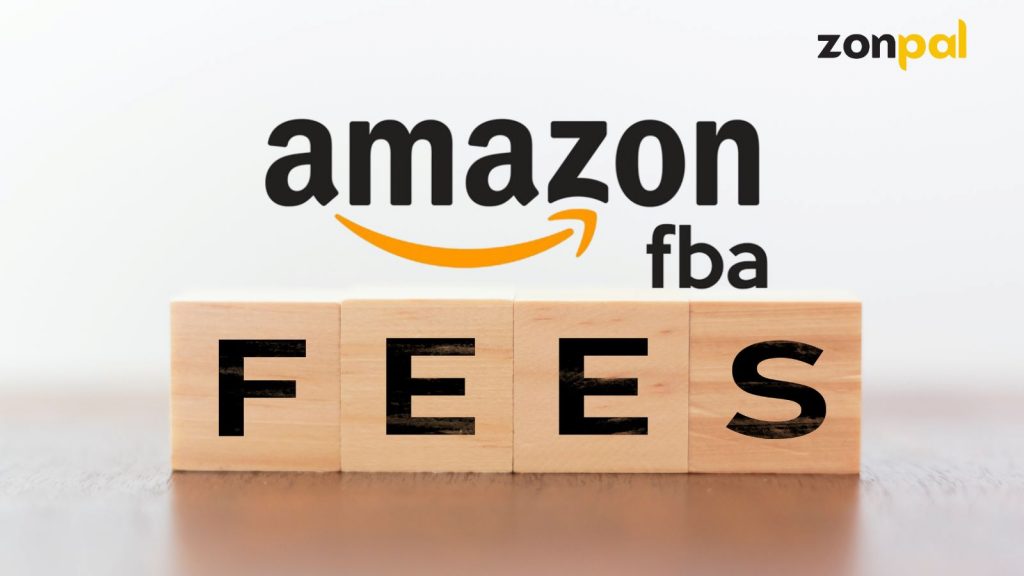
How much will it cost to start Amazon FBA?
Shopify Fees
Shopify offers three main pricing plans:
- Basic Shopify – $29/month
- Shopify – $79/month
- Advanced Shopify – $299/month
Most new sellers start with the Basic plan, which includes the essentials for launching a professional online store. If you use Shopify Payments, you won’t pay extra transaction fees. You will still have standard credit card processing rates. These rates are about 2.9% plus 30¢ per transaction in the US.
There are no per-sale platform fees unless you install third-party apps or use a different payment processor. This gives you more control over your profit margins.
For example, if you sell a product at $39.99 using Shopify Payments, you’ll only pay:
- Credit card fee: about $1.45
- No additional per-sale platform fee
- Plus your monthly subscription of $29
Even if you don’t make a sale that month, you’ll still pay your monthly plan, but you won’t lose a percentage of each sale to the platform itself.
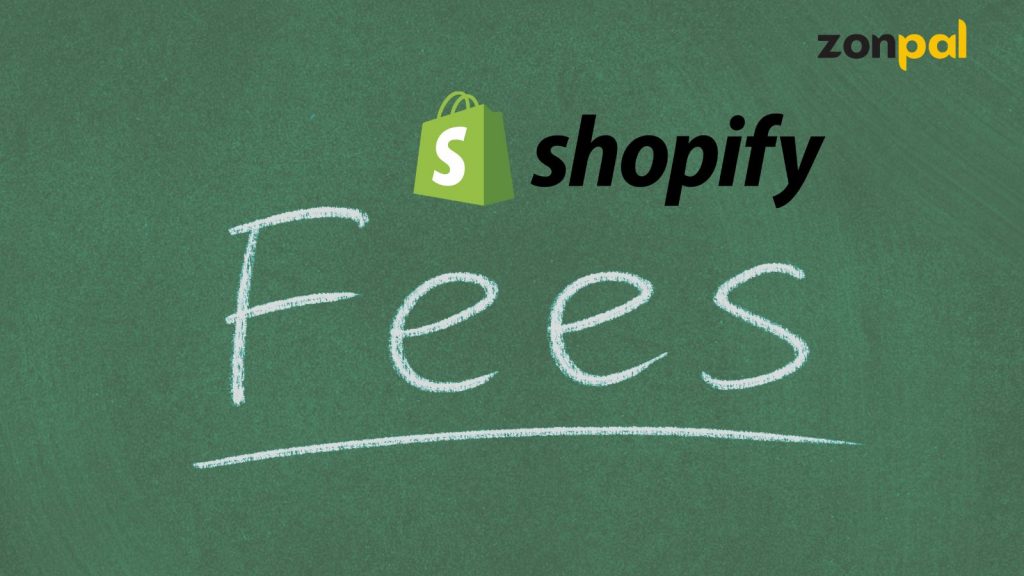
What are Shopify payout fees?
Selling On Amazon vs Shopify: Which Model Is Better For You?
Deciding between Amazon FBA and Shopify comes down to your business objectives and the level of control you prefer over your operations.
Amazon FBA is great if you want quick access to a massive audience. With FBA, Amazon handles storage, shipping, and customer service, so it’s more hands-off. But you’ll pay higher fees, have to follow strict rules, and face tough competition. You also have less control over your brand and how your products appear.
Shopify gives you full control. You build your own website, manage the design, set your rules, and create your brand identity. Fees are more predictable, and you don’t compete directly with others on the same platform. The challenge? You must bring in your own traffic, do your own marketing, and handle fulfillment unless you connect with third-party services.

Selling On Amazon Vs Shopify: Which Model Is Better?
Which One’s Better?
Go with Amazon FBA if you want fast setup, easier fulfillment, and access to ready-to-buy customers.
Choose Shopify if you’re focused on brand-building, want more freedom, and are ready to grow long-term.
>>> Read more: Amazon FBA vs FBM: Which Model is Ideal Choice for You? <<<
Amazon FBA Vs Shopify: Can I Use Both Together?
You absolutely can use both Amazon FBA and Shopify together. In fact, many successful eCommerce businesses do just that to get the best of both worlds.
How Does It Work?
You can set up your own branded store using Shopify and still fulfill orders using Amazon’s FBA service. This setup is often called Multi-Channel Fulfillment (MCF). Here’s how it works:
- A customer places an order on your Shopify store.
- Instead of packing and shipping it yourself, you let Amazon FBA handle the fulfillment.
- Amazon ships the product directly to the customer—just like it would for an Amazon order.
This way, you benefit from Shopify’s custom storefront and branding power, while also using Amazon’s fast and reliable logistics.
Pros of Using Both:
- More Sales Channels: You’re not relying on just one platform.
- Stronger Branding: Your Shopify store lets you create a unique brand experience.
- Time-Saving Fulfillment: Amazon handles the packing, shipping, and returns.
- Prime-like Shipping Speed: Customers still enjoy fast delivery times.
Things to Keep in Mind:
- FBA Fees Apply: Even when orders come from Shopify, you’ll still pay fulfillment fees to Amazon.
- Inventory Management: You’ll need to keep your Amazon stock levels updated for both platforms.
- Branding Limitations: Since Amazon handles shipping, you can’t include custom packaging unless you go with third-party fulfillment or Amazon’s “premium” options.
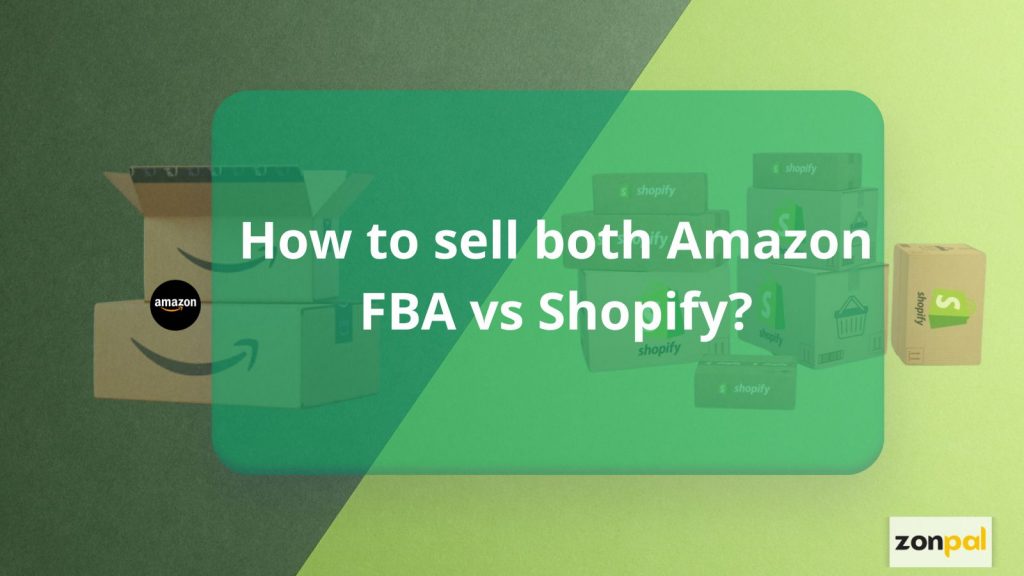
Amazon FBA Vs Shopify: Can I Use Both Together?
Conclusion
Both Amazon FBA and Shopify offer unique advantages. FBA provides fast access to a massive customer base, while Shopify gives you full control over your brand and customer experience. Your ideal choice depends on your business goals, resources, and how hands-on you want to be. You can even combine both for greater flexibility.
Do you need expert help choosing the right path? Fill out your details at [Link here] for a free personalized consultation from Zonpal.

